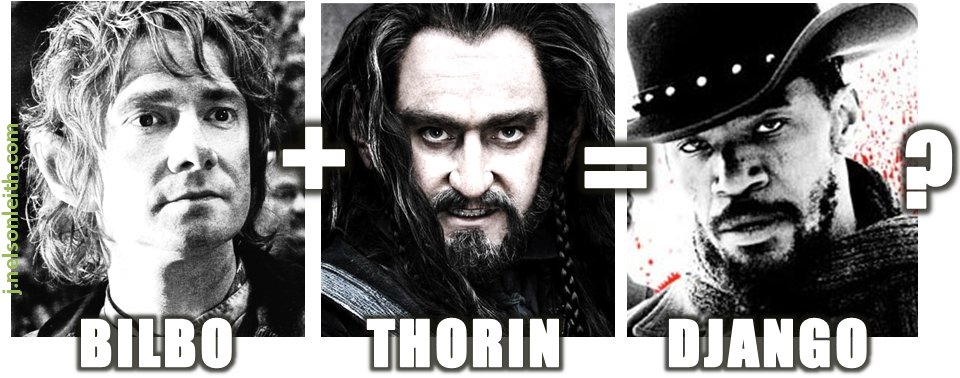 My formal training is in Religious Studies. So, while watching the film Django Unchained, I couldn’t help but keep an eye for universal mythic themes that I might have seen elsewhere. The fact that Django’s quest to retrieve his wife is specifically compared to the myth of Siegfried and the Dragon only heightened my interest.
My formal training is in Religious Studies. So, while watching the film Django Unchained, I couldn’t help but keep an eye for universal mythic themes that I might have seen elsewhere. The fact that Django’s quest to retrieve his wife is specifically compared to the myth of Siegfried and the Dragon only heightened my interest.
Oddly enough, the patterns I detected in the film invoked a completely different dragon-slayer tale: Tolkien’s The Hobbit. (The original novel, not Jackson’s ballooned-out trilogy.) If you’ve ever read The Hobbit and are planning to see Django Unchained, watch for the following twelve plot points, with Schultz playing Gandalf’s “Guru” role, Django doing double duty for Bilbo and Thorin as the “Hero,” and Calvin Candie in Smaug’s “Dragon” role:
1. Guru compels the Hero (less than voluntarily) to go on an adventure.
In The Hobbit, Bilbo is thought to belong to a people not fit for such epic quests, but he proves otherwise. This becomes a central theme in both the book and in Django, with everyone underestimating the Hero (often to their peril) except the Guru.
2. The arrangement is discussed at a place characterized by eating and drinking.
This is Bilbo’s dining room in the book. Watch for the eating-and-drinking place in Django.
3. Before the adventure really gets underway, Hero and Guru cooperate to defeat a Trio of monsters.
These would be the trolls in The Hobbit. See if you recognize the Trio in Django. HINT: They don’t turn to stone, but they are “brittle.”
4. Hero and Guru pass through the mountains, during which the Hero discovers his Power.
Bilbo’s Power is the aptly named Ring of Power, which he discovers when Gollum loses it near his underground lake. Django discovers a more personal Power in the film … but a cold, pale, watery humanoid figure plays a key role, just like in The Hobbit.
5. A forest full of wickedness is crossed, toward the Hero’s lost treasure, which is now guarded by a Dragon.
In the book, this is Thorin’s lost treasure in the Lonely Mountain. Django’s wife (whose somewhat disappointingly passive role makes more sense when you realize she is the analog for a pile of gold) is the treasure in the film.
6. Traveling through a a wooded area, the Hero encounters a lesser Antagonist.
This is Thranduil the Elvenking in the book. Calvin Candie (the Dragon) is also present in this sequence in Django, but watch carefully for the appearance of a secondary Antagonist the film’s Hero meets here.
7. Hero tries to outwit the Dragon, but Dragon merely becomes enraged.
In both The Hobbit and Django, the Dragon goes on a furious and arrogant rant in elevated language about his inherent superiority over the Hero; see if you hear the echo in Django of Smaug’s “I kill where I wish!” Also note that there is a transition in setting between where the Dragon becomes enraged and where the Dragon’s apparent victory takes place. In The Hobbit, this transition is from the Lonely Mountain to Laketown. Watch for the setting shift in Django.
8. Dragon is slain by surprise during his moment of apparent victory, shot in a special place over his heart, but not by the Hero.
In The Hobbit, Smaug is shot in the heart through a spot in his chest that is not armored. Watch carefully how this plays out in Django.
9. Other antagonistic forces (including the lesser Antagonist from the wicked forest) converge to threaten the Hero regaining his treasure.
Just as you might have mistakenly expected The Hobbit to be over once Smaug was slain, you might be fooled by the false climax of Django. There’s another battle brewing.
10. As part of a negotiation to forestall further violence, the treasure passes from the possession of the Dragon to the lesser Antagonist.
Just as the Arkenstone in The Hobbit passed from Smaug’s treasure to the Elvenking as part of a peace negotiation, Django’s treasure similarly passes from the film Dragon’s possession to the lesser Antagonist.
11. Subterfuge on the part of the Hero puts him back in the action.
In The Hobbit, Bilbo sneaks Thorin’s Arkenstone out of the Lonely Mountain in an attempt to keep the Elvenking from seizing the treasure. In Django, the Hero uses his clever side (Bilbo) to exploit his fighting side (Thorin) as a bounty hunter in a trick that I won’t spoil for those who haven’t seen the movie.
12. In a second climax, all foes are defeated, and the Hero regains his treasure.

WesT
December 30, 2012 at 12:29 pm
I’m impressed with how you connect events in the book to “things that happen” in the movie…without revealing just WHAT happens. It lets us look forward to the movie but doesn’t spoil any scenes. I’m definitely putting that movie on my list now. Thanks!